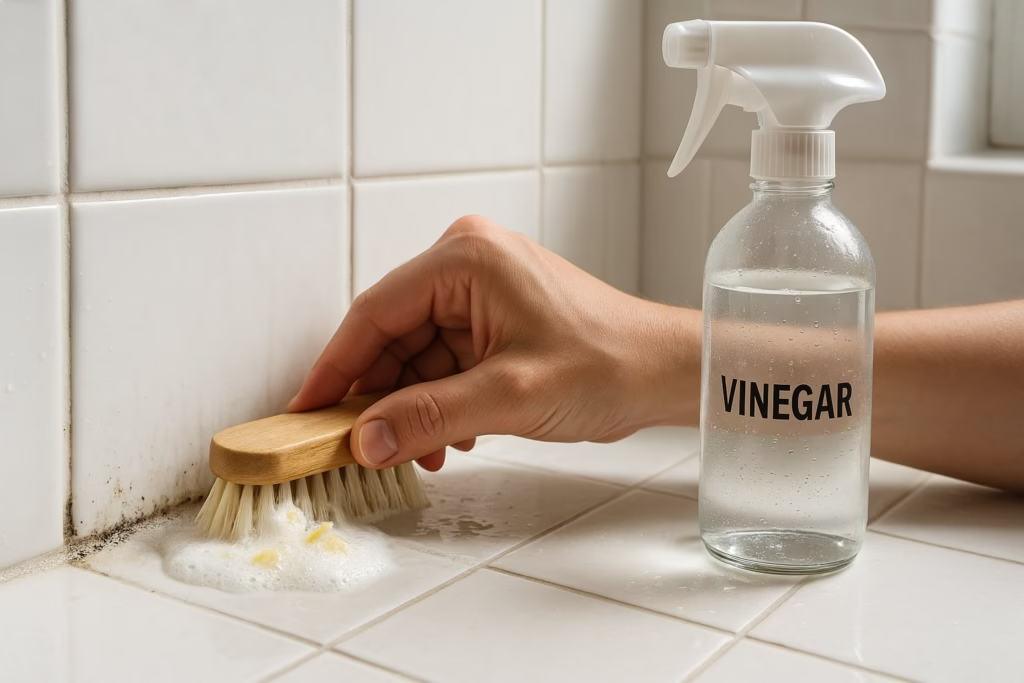Home Remedy for Mold Removal: A Simple, Safer Step-By-Step
Read time : 5 mins
Last Updated:
Introduction
For small, surface-level mold spots, you don’t need harsh cocktails or gimmicks—you need a simple routine that removes residue and keeps moisture in check.
This step-by-step shows exactly what to do on typical bathroom/kitchen surfaces, which home remedies can help, and what to avoid (including dangerous mixes). If your situation is larger, in HVAC, or inside porous materials, skip DIY and call a pro.
For a full methods hub across materials, see Home Remedies for Cleaning Mold. For bathroom specifics, use Home Remedies for Mold in Shower.
Make Sure DIY Is Appropriate (Quick Check)
DIY is fine when:
- The area is small (commonly ≤10 sq ft / ~1 m²).
- It’s on non-porous or semi-porous surfaces (tile, glass, sealed wood, painted drywall).
- You can ventilate and control moisture.
Don’t DIY if: porous materials are soaked/colonized, multiple rooms are affected, HVAC or hidden cavities are involved, or anyone has significant respiratory issues—see Home Remedies for Black Mold and contact a pro.
Gear & Setup
- PPE: gloves, eye protection, well-fitting mask.
- Ventilation: run exhaust fan, crack a window.
- Tools: microfiber cloths, soft brush, bucket, mild detergent, optional 3% hydrogen peroxide or white vinegar (use one), baking soda (optional), clean water, trash bags.
- Protect: move towels/toiletries; lay a drop cloth; keep kids/pets out.
Step-By-Step: Simple, Safer Removal
- Dry things out first. Run the fan/dehumidifier; blot standing moisture.
- HEPA vacuum loose dust if available (optional but helpful).
- Detergent scrub. Warm water + a few drops of mild detergent; scrub from clean → dirty.
- Target stains—choose ONE method:
– Vinegar (non-porous surfaces): spray, dwell 10–15 min, scrub, rinse.
– Hydrogen peroxide 3% (grout/caulk/tiles): spray/soak, dwell 10–15 min, scrub, rinse.
– Baking soda paste (localized residue): apply, scrub, rinse.
Spot-test first; never combine treatments in the same session. - Rinse with clean water. Remove residues so they don’t attract grime.
- Dry completely. Squeegee/towel; keep fan running 20–30 minutes.
- Recheck in 24–48 hours. If staining wicks back from within material, it’s likely inside—replace that section.
💡 Tip: “Killing” mold isn’t enough—physical removal + drying is what stops it from returning.
Surface Notes (Quick Guide)
- Tile & glass: detergent → vinegar or peroxide → rinse → dry.
- Grout & caulk: detergent first; spot peroxide; reseal grout when fully dry. If caulk is degraded or stains return from within, re-caulk.
- Painted drywall (sealed): gentle detergent wipe; light spot treatment only; don’t overwet. Persistent staining = replace the affected section.
- Unsealed drywall/carpet/insulation: if colonized or water-damaged, remove and replace—surface treatment won’t last.
What NOT to Do
- Never mix bleach with ammonia or acids (like vinegar).
- Don’t fog/spray and call it done—you must wipe, rinse, and dry.
- Don’t paint over active growth; fix moisture and clean first.
Keep It from Coming Back
- Keep indoor relative humidity ~30–50%.
- Ventilate bathrooms/kitchens long enough after use; squeegee showers.
- Fix leaks and condensation spots quickly; reseal grout when dry.
- Clean dust/soap film that feeds growth.
When to Call a Pro
- >10 sq ft, repeat regrowth, strong odors, or symptoms.
- HVAC/ducts or hidden cavities involved.
- Need containment, negative air, moisture logs, or insurance documentation.
- See Home Remedies for Black Mold for safety thresholds.
Conclusion
For small, surface-level spots, this simple routine—detergent scrub, a single targeted treatment, thorough rinse, and complete drying—works better than complicated mixes. Control moisture the same day and build habits (squeegee + fan time) to prevent return.
For material-specific methods across the home, use the Cleaning Mold hub; for bathroom-only tips, see the Shower guide.
By: Home Remedy Center Editorial Team
The Home Remedy Center Editorial Team researches practical, safe ways to care for your home and family. Our writers and editors fact-check every guide against reputable sources and trade standards, and we keep advice simple, realistic, and safety-first. Learn more about our Editorial Policy at Editorial Policy.
Disclaimer: This article is for educational purposes and is not medical or professional advice.
Last updated:
References / Further Reading
- EPA — A Brief Guide to Mold, Moisture and Your Home
- EPA — Mold Remediation in Schools & Commercial Buildings (methods and containment)
- CDC — Mold Cleanup Guidance (PPE and cleanup basics)
- CDC — How to Safely Clean and Sanitize with Bleach (never mix bleach & ammonia)
- NYC Dept. of Health — Guidelines on Assessment and Remediation of Fungi in Indoor Environments
FAQ
Question: What’s the best home remedy for small mold spots?
Answer: Start with detergent and water, then dry thoroughly. Use a single targeted treatment (vinegar or 3% peroxide) only if stains persist.
Question: Vinegar vs. hydrogen peroxide—how do I choose?
Answer: Both can help; never mix. Try one after a detergent clean and spot-test first. Switch on a later day if needed.
Question: Can baking soda help?
Answer: Yes, as a mild paste for localized residue after detergent cleaning. Rinse and dry so powder doesn’t trap moisture.
Question: How do I prevent it from coming back?
Answer: Keep RH ~30–50%, ventilate longer after showers/cooking, squeegee bathrooms, fix leaks quickly, and reseal grout when dry.

